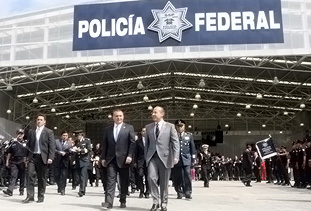
|
 |
 |
 News Around the Republic of Mexico | June 2008 News Around the Republic of Mexico | June 2008  
Federal Police Command Center Opened in Iztapalapa
 Presidencia de la República Presidencia de la República
go to original


| | President Felipe Calderón inaugurated the new Federal Police Command Center this week. | | |
Mexico City - Tuesday, President Felipe Calderón inaugurated the Federal Police Command Center, a strategic infrastructure complex that will serve as the basis for a model that will permit preventive actions and the rapid, efficient deployment of the police in Iztapalapa.

The First Police Station model was also completed, which will serve as the basis for the construction of 40 stations in over 27 states in the country, through which information will be able to be exchanged more efficiently.

During the inaugural ceremony, an agreement was signed between the Federal Public Safety Secretariat (SSP) and the State Workers’ Institute of Social Security and Services (ISSSTE) in order to provide 22,000 housing credits for federal police.

The Command Center´s Installations comprise:

• A Metropolitan Police Station, with areas for dealing with the public, such as a Module of Federal Crimes, Human Rights, Crime Victims’ Services, Control Center and Center for Telecommunications and Territorial Liaison.• Government building, where Federal Police will plan and define strategic actions, logistic and coordination operations for crime prevention and police deployment.

• Barracks for auxiliary federal forces.

• Shooting stand.

• Hangar and heliport.

• Barracks for Special Operations Group, with a capacity for 300 police officers.

The Special Operations Group is highly trained in information analysis and processing, weapons use, state of the art technology, tactical deployment and crisis intervention and resolution. This group is designed to combat organized crime through the implementation of techniques and strategies that enable specific organizations to be implemented precisely and in a timely fashion.

Special Operations Group Areas:

Explosives: inspections may be carried out with police dogs, which will detect the explosive material that uses a mechanisms based on the basic principles of forces and pulleys, hooks and strings, in order to guarantee the specialized personnel’s safety in the maneuvers undertaken during the opening of the unit.

The explosive device will subsequently be extracted and transferred, using state of the art technology such as robots which will ensure the safe handling of the bomb at a maximum distance of 250 meters by remote control.

The device will be deposited in a container with a capacity for up to 20 kilos of high concentration explosive, which, once in a safe place where it can be neutralized, will be deactivated using a gun with 250 mm antifreeze, which in turn is shot by a 29 mm cartridge which neutralizes the device by hitting it.

Intervention. This group carries out maneuvers in buildings, its aim being to ensure the safety of people and their assets and arrest suspects, for which they use two methods:

1. Registration, an operation in which there is no risk of possible human loss and all the rooms in the building are checked with sufficient time to use the techniques required by the intervention group.

2. Assault: Rapid, surprise intervention in the building, with just a few seconds to free hostages and arrest kidnappers, for which there are two methods: assault with known distribution and assault with unknown distribution.

The intervention area also carries out maneuvers in attacks on buses and urban transport taken by criminals in order to free those that have been kidnapped and assailants.

Dogs. Police dogs support the activities carried out by the Special Operations Group in Mexico by conducting random checks of messenger and delivery services, airports, bus terminals and highway check points.

The canine unit has dogs that have been specially trained in areas such as detecting explosive substances, firearms, US dollars, narcotics and human remains and there are police officer-dog teams that have been certified by the US government in the detection of explosive substances.

Source: Media and Communications Department, Social Security Secretariat (SSP). | 
 | |
 |



